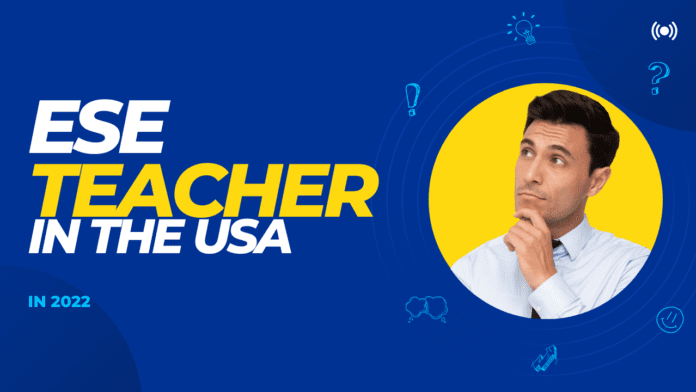In the United States, the education system strives to provide inclusive learning environments for all students, including those with exceptionalities. One integral figure in this effort is the Exceptional Student Education (ESE) teacher. ESE teachers play a crucial role in supporting and empowering students with special needs, ensuring they receive the necessary accommodations and individualized instruction to thrive academically and socially. In this article, we will explore the responsibilities, skills, and impact of an ESE teacher in the USA.
1: Understanding the Role of an ESE Teacher
The role of an ESE teacher is multifaceted and encompasses various responsibilities. They work closely with students, parents, administrators, and other educators to ensure that students with special needs receive the necessary support and accommodations to succeed academically, emotionally, and socially. ESE teachers serve as advocates for their students, working to remove barriers and provide equal opportunities for learning.
2: Qualifications and Training for ESE Teachers
ESE teachers undergo specialized training and possess the qualifications necessary to meet the unique needs of students with exceptionalities. They typically hold a bachelor’s or master’s degree in special education and relevant certifications and licenses. Additionally, continuous professional development is crucial for ESE teachers to stay updated with the latest research, teaching strategies, and legal requirements in special education.
3: Creating Inclusive Learning Environments
One of the primary objectives of an ESE teacher is to create inclusive learning environments where students with special needs can actively participate and thrive. They collaborate with general education teachers to adapt curriculum materials, instructional methods, and assessments to meet the diverse learning needs of their students. By fostering a sense of belonging and acceptance, ESE teachers promote an inclusive classroom culture that benefits all students.
4: Individualized Education Programs (IEPs)
ESE teachers are responsible for developing and implementing Individualized Education Programs (IEPs) for each student with special needs. IEPs outline the student’s goals, accommodations, and support services required to ensure their academic success. ESE teachers work closely with parents, students, and other members of the IEP team to develop comprehensive plans that address the unique strengths and challenges of each student.
5: Collaboration with Parents and Guardians
Effective collaboration with parents and guardians is vital for the success of students with special needs. ESE teachers regularly communicate with parents, providing updates on their child’s progress, discussing strategies for support, and addressing any concerns or questions. By fostering strong partnerships with families, ESE teachers ensure a unified approach to meeting the educational needs of students both in and outside the classroom.
6: Addressing Diverse Learning Needs
Students with special needs have diverse learning needs, requiring individualized attention and tailored instructional approaches. ESE teachers utilize various assessment methods to identify students’ strengths, weaknesses, and learning styles. They then adapt and differentiate instruction to meet the specific needs of each student, ensuring that they receive education at their appropriate level and pace.
7: Implementing Differentiated Instruction Strategies
Differentiated instruction is a key strategy employed by ESE teachers to accommodate the diverse learning needs of their students. By modifying content, process, and product, ESE teachers provide multiple pathways for learning, allowing students to engage with the material in ways that best suit their abilities. This approach promotes active participation, enhances comprehension, and fosters a positive learning experience for all students.
8: Assistive Technology and Adaptive Materials
Technology plays a crucial role in supporting students with special needs. ESE teachers incorporate assistive technology tools and adaptive materials into their instructional practices. These may include speech-to-text software, augmentative and alternative communication devices, specialized software for reading and writing, and other assistive devices tailored to individual student requirements. By leveraging technology, ESE teachers enable students to overcome challenges and access educational opportunities more effectively.
9: Building Positive Relationships with Students
Establishing positive relationships with students is fundamental to the success of an ESE teacher. They create a safe and nurturing environment where students feel valued, respected, and supported. By building trust and rapport, ESE teachers can better understand their students’ needs, motivations, and interests, which allows for more effective instruction and intervention strategies.
10: Advocating for Students with Special Needs
ESE teachers advocate for students with special needs, ensuring their voices are heard and their rights are protected. They collaborate with parents, school administrators, and other stakeholders to promote policies and practices that support inclusive education. By advocating for necessary resources, services, and accommodations, ESE teachers strive to remove barriers and create equal opportunities for all students.
Conclusion
ESE teachers in the USA play a pivotal role in empowering students with special needs and facilitating their academic and social growth. Through their expertise, dedication, and commitment, they create inclusive learning environments, provide individualized support, and advocate for the rights of students with exceptionalities. The impact of ESE teachers extends beyond the classroom, shaping the lives of their students and promoting a more inclusive society where everyone has an opportunity to succeed.


